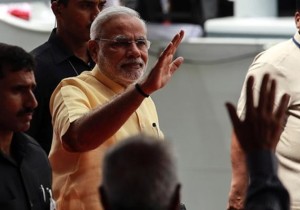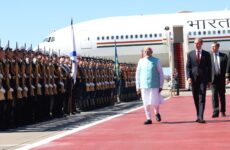 New Delhi, Prime Minister Narendra Modi, who is on a four-day official tour of Japan, said on Sunday that not only Kyoto and Varanasi, Kyoto and Indian universities, industries & research institutes can also work together.
New Delhi, Prime Minister Narendra Modi, who is on a four-day official tour of Japan, said on Sunday that not only Kyoto and Varanasi, Kyoto and Indian universities, industries & research institutes can also work together.
PM Modi today received a presentation from Kyoto Mayor Daisaka Kadokawa on how the ancient tradition of Japan’s cultural capital has been preserved while building it into a modern city, a day India signed a pact to develop Varanasi on the pattern of Kyoto.
During the 40-minute presentation, Mayor Kadokawa explained how Kyoto was cleaned up by its citizens.
He told Modi that local students actively participated in cleaning up the city and reducing the garbage to 40%.
Posters and billboards were discouraged and today the two remaining posters will be removed in the city, he said, adding that this exercise has been going on for several years.
Modi, who represents Varanasi constituency in the Lok Sabha, wants to develop the sacred Indian city into a ‘smart city’ by using the experience of Kyoto.
After meeting Kadokawa, Modi said, “In India we plan to work to develop heritage cities and that’s why I wanted to understand some things (in Kyoto).”
“The reason I came to Kyoto was primarily cultural. Kyoto has maintained its cultural heritage despite lot of troubles. Kyoto has incorporated modern needs with its cultural heritage. This city was built on the foundation of its cultural heritage. In India, we are also trying to create a heritage city,” Modi added
Daisaku Kadokawa briefed Modi about the city (Kyoto) that was the capital of imperial Japan.
PM Modi further said, “Not only Kyoto & Varanasi, Kyoto & Indian universities, industries & research institutes can also work together.”
Giving more details of PM Modi’s meet with the Kyoto Mayor, the Ministry of External Affairs (MEA) official spokesperson Syed Akbaruddin wrote on microblogging website Twitter – “1 agreement was signed yesterday which is just the 1st step, PM presented a map of historic Benares to Mayor of Kyoto.”
Modi presented a book to the Mayor in which he wrote,”I represent Benaras. I came to know how the city of Kyoto was developed.”
He also handed over a digital map of Varanasi to the Mayor, who said, “I would like to dedicate myself for promotion of interaction between India and Japan.”
“Buddhist heritage are inspired by India,” the Mayor said.
Kyoto, with around 2000 temples and shrines, has been at the crossroads of history since the end of the Nara Period (794 AD). It was the capital of Japan for over 1,000 years till the Emperor moved to Tokyo.
A Partner City MoU was signed by Indian Ambassador Deepa Wadhwa and Kyoto Mayor Kadokawa at a ceremony witnessed by Modi and his Japanese counterpart Shinzo Abe yesterday.
The MoU, which was signed soon after Modi’s arrival here on a five-day visit, provides for cooperation in heritage conservation, city modernisation and cooperation in the fields of art, culture and academics.
Further, MEA tweeted, “PM also spoke about sickle cell anaemia & interacted with CiRA Director Prof Yamanaka, discused collaboration with Indian institutes.”
Modi met Shinya Yamanaka, Japan’s stem cell pioneer and 2012 Nobel Prize winner, at Kyoto University and discussed treatment of the disease.
They discussed the “possibilities of sickle cell anaemia cure” and “prospects of cooperation among Indian and Japanese institutes”, tweeted an external affairs ministry spokesman.
“The prime minister expressed concern over the prevalence of sickle cell anaemia, especially among tribal communities across India,” a statement by the Indian government said.
Sickling decreases the cells’ flexibility and results in a risk of various life threatening complications. It mostly occurs in regions where malaria is rampant.
“The prime minister urged Yamanaka to work towards a cure for this,” the statement said.
Yamanaka said there were currently no Indian researchers at his institute, the Centre for iPS Cell Research and Application, and “he would like Indian scientists to conduct research at the institute”.
Later, PM Modi departed for Tokyo today evening, on the second day of his five-day visit to Japan.
“Goodbye Kyoto,” the external affairs ministry spokesman tweeted, as Modi ended a two-day trip to Kyoto.
PM Modi arrived here on Saturday, his Japan visit ends on September 03.




 Driving Naari Programme launched in Chandigarh
Driving Naari Programme launched in Chandigarh






























